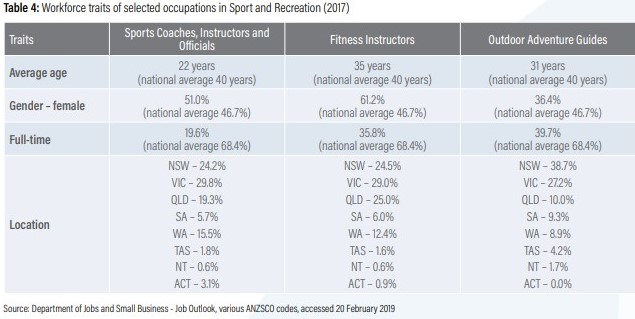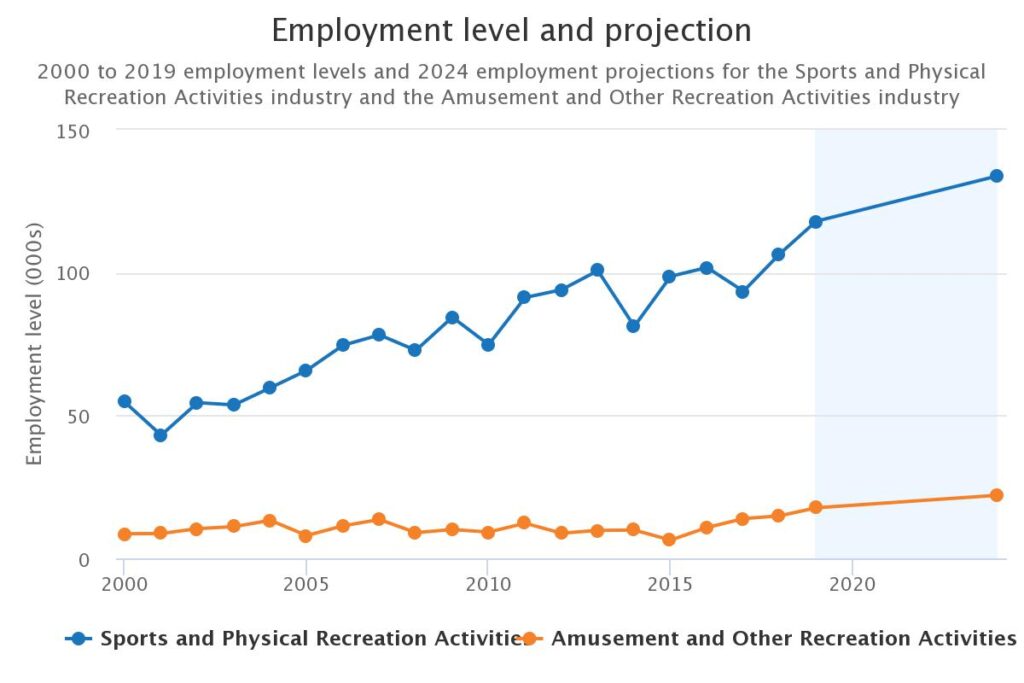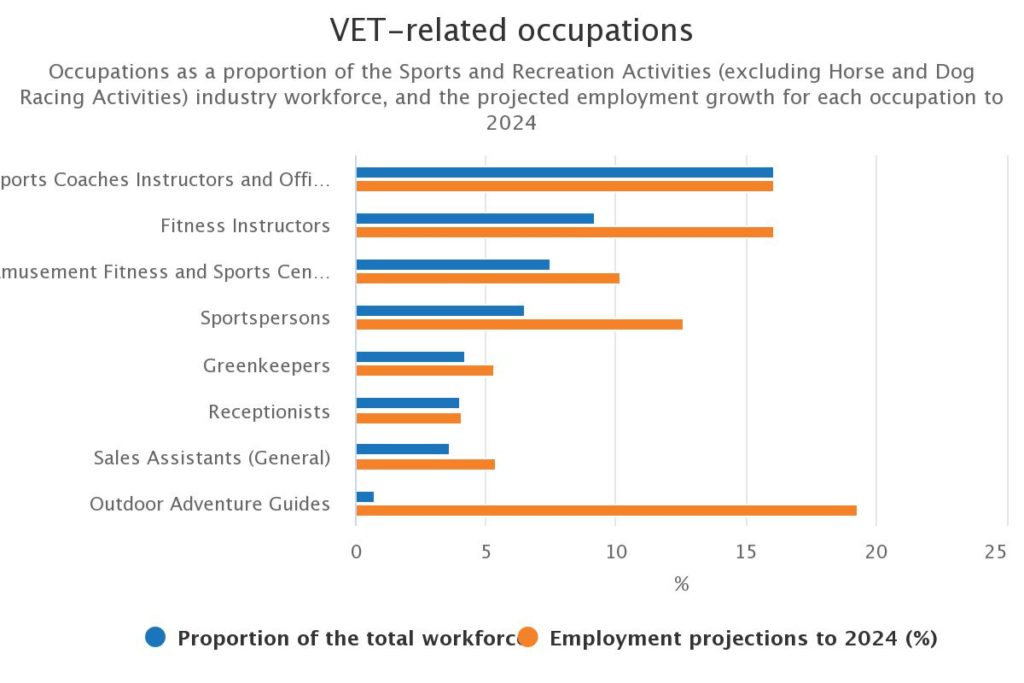The Importance of the Fitness Industry
The fitness industry plays a crucial role in Australia, serving as a source of jobs, investment, expenditure, innovation, and physical and mental health. Predominantly, the fitness industry comprises health clubs, fitness and leisure centers, fitness franchises, indoor and outdoor personal training, and smaller fitness studios, including yoga and pilates. These businesses offer a diverse range of services. For instance, they provide personal training, group exercise classes, casual gym entry or membership, and merchandise.(1)

Australian’s spend an estimated $8.5 billion on fitness each year. The fitness industry’s total employment contribution is 35,000 persons and the number of businesses totals 6,426. With a collective membership Pre-COVID of 3.7 million people. (1)
Key players in the fitness industry are personal trainers who provide one-on-one and small-group fitness training. Over the past five years the personal training profession has experienced a 4.9% annual growth and $508.5 million in revenue in 2018–19. (2)
Looking to the Future: Australian Fitness Industry
There are many reasons to be optimistic about the future of Australia’s fitness industry post COVID-19. Job advertisements are returning. Last week (29/6/2020) there were high numbers of jobs being advertised in sections of the community that are opening up.
- A scan of seek showed 420 job advertisements for personal trainers Australia wide. (4)
- The local fb group “Fitness Instructors / Fitness Groups Brisbane Western Suburbs” reported record job vacancies with 44 new job ads last week. (5)
- The Fit Education Job Board had the most job advertisements ever last week. In the 2km radius of head office there are 5 job advertisements for the 8 fitness operators. (6)
Clients are keen to resume their fitness regimes within their fitness communities. And with that exciting opportunities await those looking for careers in the fitness industry. This higher than expected job growth is the V or U shaped recovery talked about by economists. Once this settles it would be reasonable to expect that the fitness industry would return to the pre-covid growth levels of 18.4% to 2023 . Sports Coaches, Instructors and Officials, are also forecast to experience very strong growth.

Graph: Employment levels (May 2018 and May 2023) and forecast % growth to May 2023 – selected occupations in Sport and Recreation (2)

Workforce traits of selected occupations in Sport and Recreation (2017) (2)

Employment Level and Projection: (2)

VET Related occupations (2)

Personal Trainer Seek data (4)
The Importance of Health and Fitness to Australia.
The increased health consciousness due to COVID-19; an ageing population; and increasing obesity rates will mean increased work for the fitness sector.
Better community health provides a range of economic benefits. Importantly, it can provide the opportunities and freedom to lead more active, healthy and productive lives. Improvements in community health radiate out to the rest of the economy by reducing health care costs, improving mental health, enhancing workforce productivity and increasing the amount of labour available (for example, through lifting the number of people participating in the workforce).
Economic Benefits of Fitness Centers in Australia
Australia’s fitness centers provide savings in direct health care costs of up to $108 million per annum. Further economic modelling has revealed that a 3% increase in fitness center utilisation by the adult population has the potential to deliver additional health care savings in the order of $204.8 million and lead to around 2,609 extra full-time employees in the workforce.(3)
With the national and state health budgets growing at an alarming and unsustainable rate, government is increasingly seeking solutions such as those offered by the fitness industry to avoid spiralling health care costs that are largely preventable. (2)
- Australian Bureau of Statistics National Health Survey (2017-18) reported that two-thirds (67.0%) of Australian adults are overweight or obese (12.5 million people)
- It has been estimated that the cost of physical inactivity to the Australian economy is $13.8 billion.
- It is estimated that 16,178 Australians die prematurely each year due to physical inactivity. Productivity loss due to physical inactivity equates to 1.8 working days per worker per year.
The Economic and Public Health Benefits of Physical Activity for Mental Health in Australia
The cost to the Australian economy of mental ill health and suicide is estimated at around $43bn-$51bn a year. Additional to this is an approximately $130bn a year cost associated with diminished health and reduced life expectancy for those living with mental ill health. Broader social effects such as the cost of mental health stigma or lower social participation were not quantified in the report.
Physical activity is an important public health tool used in the treatment and prevention and/or maintenance of depression and anxiety disorders. The mental and emotional benefits of exercise include sharper memory and thinking, higher self-esteem, better sleep, more energy and stronger resilience. Regular exercise reduces stress and symptoms of mental health conditions and can help with recovery from mental health issues. Exercise stimulates hormones that improve mood and parts of the brain responsible for memory, learning and builds an individuals immune function.
Other Future Opportunities for the Fitness Industry.
Fitness professionals are an ingenious bunch. Just under half of the gyms have been able to generate new sources of ongoing income (with the majority moving customers to virtual training) during COVID-19. Some other takeaways to consider as we emerge from the pandemic:
- People are craving connections through exercise
- Kids not exercising is a major concern.
- Live streaming will live on
- Individualised solutions: Just as different body types need different fitness programs, this approach will also apply to reopening. Generations will manage risk differently. It is important to be nimble and agile. Think about geographies, generations, and risk, there will not be a one size fits all approach.
- Follow clients into the anytime and anywhere fitness model – At home and travel. The pandemic has bought the idea of the club into the house
- The fitness sector delivers a range of long term social and economic benefits across the community. It is no doubt in the interests of government and the fitness industry to work together to benefit.
- Future growth in the sector is determined by include increased discretionary income and increased health consciousness due to an ageing population and increasing obesity rates. The industry remains exposed to domestic economic conditions. (2)
- Over 80 per cent of staff at fitness centers are employed on a casual or part‐time basis. Issues impacting the fitness workforce include wages, general work conditions, the transient nature of employment, and underemployment. (2)
Embracing Technology in the Fitness Industry
Fitness businesses that work with new technology rather than viewing it as a threat to their existence will benefit both their clients and their businesses. From online training, to remote diet and exercise consultations, there are now numerous ways that fitness business can use technology. It is important for fitness trainers to adapt to the changes brought on by COVID-19, embrace what is now available and be aware of where the industry/world is headed.
Disclaimer: Obviously this article looks at the fitness industry from a glass half full approach with Fit Education having an interest in fitness courses.
References
- FITNESS AUSTRALIA COVID-19 FITNESS INDUSTRY IMPACT REPORT https://bpfitnessaustraliaproduction.s3.amazonaws.com/uploads/uploaded_file/file/472634/COVID-19_Fitness_Industry_Impact_report_F.pdf
- SPORT AND RECREATION 2019 INDUSTRY REFERENCE COMMITTEE INDUSTRY SKILLS FORECAST https://www.aqia.org.au/industry-skills-forecast/
- Fitness Industry Economic Contribution Report https://fitness.org.au/articles/fitness-industry-economic-contribution-reports/fitness-industry-economic-contribution-report/21/49/19
- https://www.seek.com.au/career-advice/role/personal-trainer
- https://www.facebook.com/groups/1048095208534518
- https://fiteducation.edu.au/jobs/
Fitness Graduates in Action
Check out how Fit Education Graduates are making differences in people’s lives and kicking goals on Fit Education tube.
If you found this article interesting you may also enjoy Gym Managers – Employment Statistics, or Employment Statistics for Personal Trainers.
